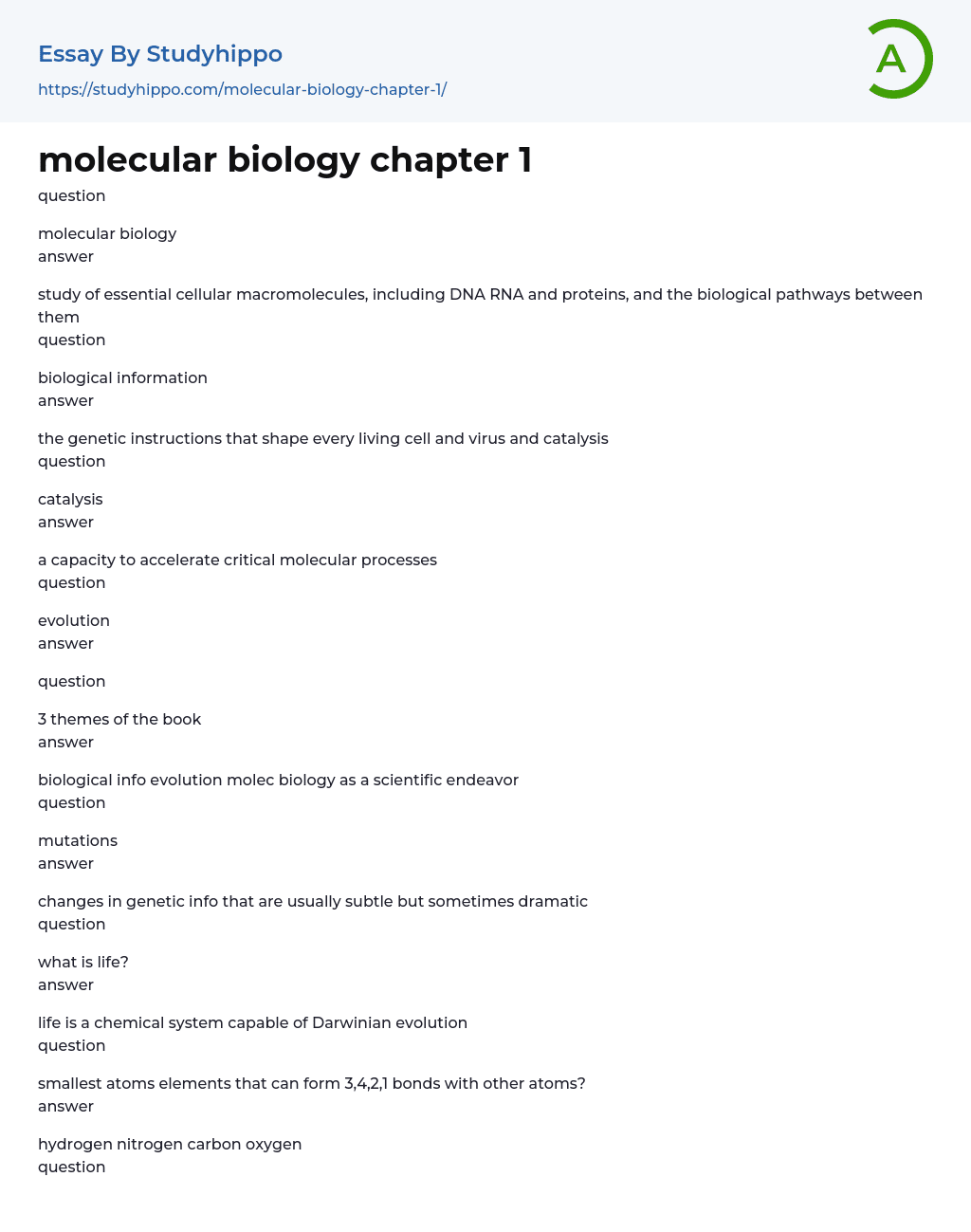cal information
return;
}
if (position === 'end') {
return this.substring(startIndex);
}
else {
return this.slice(startIndex, endIndex);
}
};
})();
< div class = " flash card_q "> adaptation
< div class = " flash card_img ">
< / div >
< div class = " flash card_a ">
< span class = " lbl "> answer
< div class = " flash card_a_text "> cells and organisms are sensitive and respond to their external environment.
+In this case, the cell is increasing its internal salt concentration to adjust to ionic changes in the external medium.
class="flashcard__q">homeostasis
The larger organizational categories include species, populations, and ecosystems.
Most enzymes, proteins or RNA molecules, are essential for a cell's functioning. They determine the cell's nutrient intake, growth rate,
waste elimination, cellular membrane construction, response to other cells, and reproduction. Another area of study is evolution and development (evo-devo), which focuses on minor changes in regulatory processes that lead to significant organismal transformations. The RNA world hypothesis proposed by Carl Woese, Francis Crick, and Leslie Orgel suggests the existence of a living system based on RNA. This system would include various RNA enzymes capable of catalyzing reactions to synthesize life-sustaining molecules from simpler environmental molecules. Replicators would be present to duplicate all RNA catalysts within this system. Furthermore, the RNA organism is defined by its boundaries as it operates out of equilibrium with its environment.
question< / span >
The last universal common ancestor (LUCA) is the most recent organism from which all organisms on Earth descend. It is believed to have lived around 3.5 to 3.8 billion years ago, and it represents a hypothetical organism that gave rise to all life as we know it today.
to all life now present on earth
vvvvbaaadad
>
dsvnsalijkfnasldjf
asdnfipasdf
sadkl;nfkjasd;lkmnasd;lkhdsa;kjfsakljdflkajsdlkfjsapofkaslkdfjoaskdjfalksdjfiosadjfoi;jadsfjoiwaeuifpioweufpsdklfhsakklsdjfoiewurieowufksadf
sakdhfkashkdhasffdsafdsfdsklhfslkshdllkjfgljglrjeoioiueroierueoreuroeuoruruoeioruerourieyrieyroireoyeoiryeoriyrioeryoireuyeroyeiryoeriyeoryeiroyreiyyreiryeruoeruy
vvvvbaaadad
>
objectivity
The application of the scientific method allows us to comprehend that science cannot succeed in a universe that deceives us. The term "scientific method" pertains to the process initiated by questioning nature. Observations are made and a hypothesis is formulated to explain them. This hypothesis serves as an initial idea or proposal, providing a reasonable explanation for one or more observations, but lacking sufficient experimental tests for support. To withstand rigorous critical examination, experiments are conducted to test assumptions based on the hypothesis. A "scientific theory" surpasses a hypothesis by offering an explanation for a collection of experimental observations and serves as a solid foundation for further investigation. Once a scientific theory has undergone repeated testing and validation through various types of experiments, it becomes acknowledged as a "fact." When the hypothesis is rejected, accepted, or modified, it prompts the inquiry of determining the minimal set of genes necessary in a living cell. This question is presented within a single__flashcard div container containing both the q_and_img div with the question label and flashcard__q div featuring the actual question itself.The flashcard__img div remains empty. The answer to this question resides within a flashcard__a div container which includes both an answer label and flashcard__a_text div presenting the answer itself.The following response outlines the potential for
scientists to develop a designed cell in the near future, which can have practical applications in bioremediation and biofuel production. It also discusses how this research may offer insights into LUCA (Last Universal Common Ancestor). Furthermore, it notes that researchers have successfully created a synthetic version of the Mycoplasma mycodes bacterium's genome and implanted it into host cells by replacing their existing DNA.
Researchers from academic institutions and the biotechnology industry worldwide are optimistic that inhibiting bacterial stress responses to DNA damage can help slow down the development of antibiotic resistance in pathogenic bacteria. This resistance has become a growing concern in medical treatments.
- John Locke essays
- 9/11 essays
- A Good Teacher essays
- A Healthy Diet essays
- A Modest Proposal essays
- A&P essays
- Academic Achievement essays
- Achievement essays
- Achieving goals essays
- Admission essays
- Advantages And Disadvantages Of Internet essays
- Alcoholic drinks essays
- Ammonia essays
- Analytical essays
- Ancient Olympic Games essays
- APA essays
- Arabian Peninsula essays
- Argument essays
- Argumentative essays
- Art essays
- Atlantic Ocean essays
- Auto-ethnography essays
- Autobiography essays
- Ballad essays
- Batman essays
- Binge Eating essays
- Black Power Movement essays
- Blogger essays
- Body Mass Index essays
- Book I Want a Wife essays
- Boycott essays
- Breastfeeding essays
- Bulimia Nervosa essays
- Business essays
- Business Process essays
- Canterbury essays
- Carbonate essays
- Catalina de Erauso essays
- Cause and Effect essays
- Cesar Chavez essays
- Character Analysis essays
- Chemical Compound essays
- Chemical Element essays
- Chemical Substance essays
- Cherokee essays
- Cherry essays
- Childhood Obesity essays
- Chlorine essays
- Classification essays
- Cognitive Science essays


Unfortunately copying the content is not possible
Tell us your email address and we’ll send this sample there.
By continuing, you agree to our Terms and Conditions.


